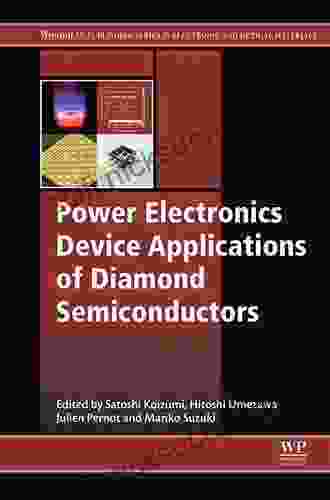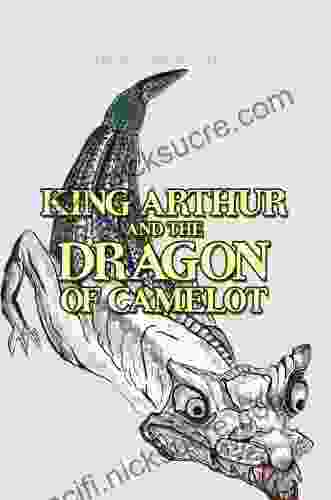Materials, Devices, and Applications in Electronics: A Comprehensive Guide

: The Foundation of Modern Electronics
The world of electronics is built upon a foundation of materials, devices, and their intricate interactions. Understanding these fundamental building blocks is essential in unlocking the vast potential of electronic technology. In this article, we embark on a comprehensive exploration of materials, devices, and their applications in electronics, delving into their properties, fabrication methods, and practical uses in various electronic devices.
4.6 out of 5
| Language | : | English |
| File size | : | 19094 KB |
| Text-to-Speech | : | Enabled |
| Screen Reader | : | Supported |
| Enhanced typesetting | : | Enabled |
| Print length | : | 968 pages |
Materials in Electronics: A Building Block Symphony
Materials play a pivotal role in the realm of electronics, offering a diverse array of properties that enable the realization of electronic devices with specific functionalities. Let's delve into the key types of materials used in electronics:
Semiconductors: The Heart of Electronics
Semiconductors, materials with electrical conductivity intermediate between conductors and insulators, form the cornerstone of modern electronics. Their ability to modulate electrical current flow makes them indispensable for transistors, integrated circuits, and many other electronic devices. Silicon, germanium, and gallium arsenide are commonly used semiconductors.
Insulators: Electrical Gatekeepers
Insulators, materials with negligible electrical conductivity, serve as barriers to current flow. They are used to isolate different parts of electronic circuits, prevent short circuits, and protect sensitive components from electrical damage. Common insulators include rubber, plastics, and ceramics.
Conductors: Superhighways for Electricity
Conductors, materials with high electrical conductivity, allow electric current to flow freely. They are used in wires, cables, and other components to facilitate the efficient transmission of electrical signals. Copper, aluminum, and gold are widely used conductors.
Magnetic Materials: Controlling Magnetism
Magnetic materials exhibit properties that enable them to interact with magnetic fields. They are used in transformers, inductors, and magnetic recording devices. Iron, steel, and certain alloys are commonly used magnetic materials.
Dielectric Materials: Storing Electrical Energy
Dielectric materials are non-conducting materials that can store electrical energy when subjected to an electric field. They are used in capacitors, which store electrical charge, and in high-frequency circuits. Common dielectric materials include ceramics, plastics, and mica.
Devices in Electronics: The Fabric of Electronic Functionality
Electronic devices are the building blocks of electronic systems, performing specific functions to process, store, or transmit information. Here are some key types of electronic devices:
Transistors: Electronic Switches and Amplifiers
Transistors are semiconductor devices that act as electronic switches or amplifiers. They control the flow of current in a circuit, enabling the creation of logic gates, memory elements, and other essential electronic circuits.
Diodes: One-Way Electrical Valves
Diodes are semiconductor devices that allow current to flow in only one direction. They are used in rectification, voltage regulation, and other applications.
Integrated Circuits (ICs): Miniaturized Electronic Brains
Integrated circuits are complex electronic circuits fabricated on a single semiconductor chip. They contain millions or even billions of transistors and other components, enabling the realization of complex electronic systems in a compact and efficient manner.
Capacitors: Energy Storage and Filtering
Capacitors store electrical energy and release it when needed. They are used in power supplies, filters, and other applications.
Inductors: Energy Storage and Current Control
Inductors store electrical energy in a magnetic field and release it when the current through them changes. They are used in power supplies, filters, and other applications.
Applications of Materials and Devices in Electronics: A World of Possibilities
Materials and devices combine to enable a vast array of electronic applications that touch every aspect of modern life. Here are some key examples:
Consumer Electronics: Entertainment and Communication
Materials and devices power our smartphones, computers, televisions, and other consumer electronics, enabling us to connect, communicate, and access information and entertainment.
Industrial Electronics: Automating Processes
Electronic devices are used in industrial automation systems, controlling machinery, robots, and other equipment to improve efficiency and productivity.
Medical Electronics: Advancing Healthcare
Materials and devices enable medical imaging, diagnostic equipment, and therapeutic devices, enhancing patient care and advancing healthcare outcomes.
Transportation Electronics: Powering Vehicles
Electronic devices play a crucial role in modern vehicles, controlling engines, safety systems, and infotainment systems, improving safety, efficiency, and driving experience.
Renewable Energy Electronics: Harnessing Nature's Power
Electronic devices are used in solar panels, wind turbines, and other renewable energy systems, enabling the efficient conversion and storage of renewable energy sources.
Challenges and Future Directions: Shaping the Electronic Landscape
The field of materials, devices, and applications in electronics is constantly evolving, facing challenges and driving advancements towards new frontiers. Some key challenges and future directions include:
Miniaturization: Shrinking Device Size for Enhanced Performance
The ongoing drive for miniaturization in electronic devices poses challenges in material engineering, device design, and fabrication techniques. Smaller devices offer increased performance and efficiency, but require innovative approaches to overcome physical limitations.
Energy Efficiency: Powering Devices with Less Energy
Reducing energy consumption in electronic devices is a critical concern, especially for mobile devices and large-scale systems. Novel materials and device architectures are being explored to improve energy efficiency and reduce environmental impact.
Novel Materials: Exploring Beyond Traditional Boundaries
Researchers are continually exploring new materials with unique properties, such as graphene, 2D materials, and organic semiconductors. These materials offer the potential for breakthroughs in electronic device performance and functionality.
Advanced Manufacturing Techniques: Precision and Efficiency in Device Fabrication
Advances in manufacturing techniques, such as nanolithography and 3D printing, enable the precise fabrication of complex electronic devices with enhanced precision and efficiency. These techniques are crucial for realizing the full potential of emerging materials.
Sustainability: Environmentally Conscious Electronics
Growing environmental concerns necessitate the development of sustainable materials and devices for electronics. Biodegradable materials, recyclable components, and energy-efficient designs are becoming increasingly important.
: Electronics: A Dynamic Field of Innovation
The field of materials, devices, and applications in electronics is a dynamic and rapidly evolving domain, driven by technological advancements, scientific research, and societal needs. From the fundamental properties of materials to the intricate functionality of electronic devices, understanding these building blocks is essential for harnessing the transformative power of electronics. The challenges and future directions discussed in this article provide glimpses into the exciting possibilities that lie ahead in this ever-evolving field, shaping the technological landscape of the future.
4.6 out of 5
| Language | : | English |
| File size | : | 19094 KB |
| Text-to-Speech | : | Enabled |
| Screen Reader | : | Supported |
| Enhanced typesetting | : | Enabled |
| Print length | : | 968 pages |
Do you want to contribute by writing guest posts on this blog?
Please contact us and send us a resume of previous articles that you have written.
 Fiction
Fiction Non Fiction
Non Fiction Romance
Romance Mystery
Mystery Thriller
Thriller SciFi
SciFi Fantasy
Fantasy Horror
Horror Biography
Biography Selfhelp
Selfhelp Business
Business History
History Classics
Classics Poetry
Poetry Childrens
Childrens Young Adult
Young Adult Educational
Educational Cooking
Cooking Travel
Travel Lifestyle
Lifestyle Spirituality
Spirituality Health
Health Fitness
Fitness Technology
Technology Science
Science Arts
Arts Crafts
Crafts DIY
DIY Gardening
Gardening Petcare
Petcare Emma Fick
Emma Fick Raghuram Rajan
Raghuram Rajan Kim Heldman
Kim Heldman James Oseland
James Oseland Huan Yang
Huan Yang Mones Abu Asab
Mones Abu Asab Gordon H Chang
Gordon H Chang Lewis Howes
Lewis Howes Sevki Kuruoglu
Sevki Kuruoglu James Morgan Ayres
James Morgan Ayres Matt Harrison
Matt Harrison Ed Palattella
Ed Palattella Borja Loma Barrie
Borja Loma Barrie Jennifer L Lopez
Jennifer L Lopez Kazumi Tabata
Kazumi Tabata Mia Reyes
Mia Reyes Jody Hedlund
Jody Hedlund Josephine Diebitsch Peary
Josephine Diebitsch Peary Bradley Mayhew
Bradley Mayhew Lee Mcintyre
Lee Mcintyre Marc P Steinberg
Marc P Steinberg Craig Callender
Craig Callender Theodore Dalrymple
Theodore Dalrymple Pamela A Hays
Pamela A Hays Christine Lion
Christine Lion Jayne Storey
Jayne Storey Laura J Snyder
Laura J Snyder Cal Pater
Cal Pater Gary Letcher
Gary Letcher Rachel Burgess
Rachel Burgess Philip Slayton
Philip Slayton Jacob Paul Patchen
Jacob Paul Patchen Michael R Canfield
Michael R Canfield Charles H Townes
Charles H Townes Derek Cheung
Derek Cheung Terri Jean
Terri Jean Scott Waldie
Scott Waldie Marion Zimmer Bradley
Marion Zimmer Bradley Jeff Carreira
Jeff Carreira Collegiate Learning
Collegiate Learning Sigmund Freud
Sigmund Freud Tara Lazar
Tara Lazar Glen Mourning
Glen Mourning Nfhs
Nfhs Robert J Sternberg
Robert J Sternberg L Waxy Gregoire
L Waxy Gregoire Stephen Armstrong
Stephen Armstrong Melissa Gomes
Melissa Gomes Raymond Barrett
Raymond Barrett Dr Barbara Sorrels
Dr Barbara Sorrels Elizabeth Hay
Elizabeth Hay Zola Levitt
Zola Levitt Nancy H Diepenbrock
Nancy H Diepenbrock Daniel Kahneman
Daniel Kahneman Loralee Leavitt
Loralee Leavitt Ross Mccluney
Ross Mccluney Richard Williams
Richard Williams Jen Rose Smith
Jen Rose Smith Karen Ehman
Karen Ehman Zecharia Sitchin
Zecharia Sitchin Laura Freberg
Laura Freberg Helen Corcoran
Helen Corcoran Julie Des Jardins
Julie Des Jardins Sherman Alexie
Sherman Alexie Maggie Smith
Maggie Smith Michael Hoy
Michael Hoy Bill Nason
Bill Nason Diane Sticks Harsha
Diane Sticks Harsha Clinton Dobbins
Clinton Dobbins Theodore Gray
Theodore Gray Immigration Consult
Immigration Consult William Spencer
William Spencer Ceara Comeau
Ceara Comeau Martin Gardner
Martin Gardner Deirdre A Scaggs
Deirdre A Scaggs Joe Hendershott
Joe Hendershott Luisa Magarian
Luisa Magarian Carol A Dahir
Carol A Dahir Sally Moran
Sally Moran Ron Woldoff
Ron Woldoff Becca Anderson
Becca Anderson Cecilia Chrapkowska
Cecilia Chrapkowska Yaron Seidman
Yaron Seidman Fred Medina
Fred Medina Jim Murphy
Jim Murphy J M Hofer
J M Hofer Ruth M Tappen
Ruth M Tappen Richard J Foster
Richard J Foster Luke Jackson
Luke Jackson Greg Mcmillan
Greg Mcmillan Christopher Setterlund
Christopher Setterlund Mary Beard
Mary Beard Darwin V Ellis
Darwin V Ellis Daniel Isberner
Daniel Isberner Sheila Willcox
Sheila Willcox Tom Billinge
Tom Billinge Jerry Darkes
Jerry Darkes Melissa Marr
Melissa Marr Russell Bryant
Russell Bryant Michael Loynd
Michael Loynd Malcolm Williams
Malcolm Williams Eva Ibbotson
Eva Ibbotson Nando Parrado
Nando Parrado Jennifer Pastiloff
Jennifer Pastiloff Tony Hansen
Tony Hansen Michael Kodas
Michael Kodas Tracy Moore
Tracy Moore Kelly Koerner
Kelly Koerner Sacha Koborsi Tadros
Sacha Koborsi Tadros Jacqueline Kelleher
Jacqueline Kelleher Jeannie Tyrrell
Jeannie Tyrrell Joni Levine
Joni Levine Detlev Piltz
Detlev Piltz Gao Yisheng
Gao Yisheng Robert Fisher
Robert Fisher Jessica Mayer Koren
Jessica Mayer Koren Jason R Briggs
Jason R Briggs Nurse Academy
Nurse Academy Sharon M Ravitch
Sharon M Ravitch Matt Davids
Matt Davids Jennifer Mccully
Jennifer Mccully Grace Elizabeth Hale
Grace Elizabeth Hale Roger Kopanycia
Roger Kopanycia Karen George
Karen George Three Over Eight Learning
Three Over Eight Learning Second Edition New Edition Updated Revised...
Second Edition New Edition Updated Revised... William Shakespeare
William Shakespeare Phillip Stephen Schulz
Phillip Stephen Schulz Chuck Carlson
Chuck Carlson Shane Burcaw
Shane Burcaw Jerry A Coyne
Jerry A Coyne Cheryl Marlene
Cheryl Marlene Sandra Brown
Sandra Brown Peter N Peregrine
Peter N Peregrine Karen Gershowitz
Karen Gershowitz Joe Tasker
Joe Tasker Smart Reads
Smart Reads Dinesh Kumar Goyal
Dinesh Kumar Goyal Michelle Garnett
Michelle Garnett Sergey K Aityan
Sergey K Aityan Simeon Wright
Simeon Wright Jack Cavanaugh
Jack Cavanaugh Bob Thomas
Bob Thomas Chantal Sicile Kira
Chantal Sicile Kira Kevin Williams
Kevin Williams Brenda Hiatt
Brenda Hiatt Carol Mccloud
Carol Mccloud Jennifer Niven
Jennifer Niven Charmaine Mckissock
Charmaine Mckissock James Mooney
James Mooney Joseph Campbell
Joseph Campbell Mary J Macleod
Mary J Macleod Peter Ralston
Peter Ralston Peter Byrne
Peter Byrne Dan Gable
Dan Gable Patrisia Gonzales
Patrisia Gonzales Rohan Agarwal
Rohan Agarwal David Franklin
David Franklin James Lovegrove
James Lovegrove Culture Smart
Culture Smart Kevin C Kelleher Md Md
Kevin C Kelleher Md Md Tiffany Loggins Psyd
Tiffany Loggins Psyd Lily Field
Lily Field Taste Of Home
Taste Of Home Michael Conway
Michael Conway Jennifer Boyle
Jennifer Boyle Leo Baker
Leo Baker Mark Vonnegut
Mark Vonnegut Julie Dubrouillet
Julie Dubrouillet Kathryn Mcelroy
Kathryn Mcelroy Timothy Alberino
Timothy Alberino Shaana Berman
Shaana Berman Monica Mcgoldrick
Monica Mcgoldrick Monica Gribben
Monica Gribben Angela Stevens
Angela Stevens Julia Shaw
Julia Shaw Paul Orland
Paul Orland John Andrisani
John Andrisani Ed Viesturs
Ed Viesturs Sian O Gorman
Sian O Gorman Carrie Rogers Whitehead
Carrie Rogers Whitehead Jennie Naidoo
Jennie Naidoo Camille Soulier
Camille Soulier Donald Hanley
Donald Hanley Diane Ehrensaft
Diane Ehrensaft Catherine Ryan Gregory
Catherine Ryan Gregory Nick Muxlow
Nick Muxlow James Duggan
James Duggan Pat Harvey
Pat Harvey Steven A Finkler
Steven A Finkler Tania Marshall
Tania Marshall Bill Nowlin
Bill Nowlin Ronald D Mcelroy
Ronald D Mcelroy Greg Wolfe
Greg Wolfe Nikki Glandon
Nikki Glandon Lynn A Struve
Lynn A Struve Lola Glass
Lola Glass Curt Sampson
Curt Sampson Bob Gaines
Bob Gaines Rachel Marie Martin
Rachel Marie Martin Joanna Breyer
Joanna Breyer Matthias Biehl
Matthias Biehl Chris Cheng
Chris Cheng Jimmy Roberts
Jimmy Roberts Xiran Jay Zhao
Xiran Jay Zhao Brian Zepka
Brian Zepka Kevin Ticen
Kevin Ticen Lynn E Ponton
Lynn E Ponton Tom Mccoy
Tom Mccoy Paul Bellow
Paul Bellow 1st Ed 2021 Edition Kindle Edition
1st Ed 2021 Edition Kindle Edition Hugh Marriott
Hugh Marriott Randall M Rueff
Randall M Rueff Lieven Vandenberghe
Lieven Vandenberghe Martin Toms
Martin Toms Karen Le Billon
Karen Le Billon Bob Brister
Bob Brister Robin Moore
Robin Moore Steve Leonard
Steve Leonard Eric R Dodge
Eric R Dodge Terry Mcmillan
Terry Mcmillan Cindy C Bennett
Cindy C Bennett Tehlor Kay Mejia
Tehlor Kay Mejia Language Guru
Language Guru Ed Gruver
Ed Gruver Don Currie
Don Currie David L Cook
David L Cook Mathew Tekulsky
Mathew Tekulsky George G Morgan
George G Morgan Staff Of The Harvard Crimson
Staff Of The Harvard Crimson Jodi Magness
Jodi Magness Candace Walsh
Candace Walsh Robert Courland
Robert Courland Alan Anderson
Alan Anderson Robert T Pennock
Robert T Pennock David Christian
David Christian James Atkinson
James Atkinson Norm Flayderman
Norm Flayderman Pedro Urvi
Pedro Urvi Silvan S Schweber
Silvan S Schweber Leigh Calvez
Leigh Calvez John Gierach
John Gierach Daniel Friebe
Daniel Friebe Kayvan Shokrollahi
Kayvan Shokrollahi Lianna Marie
Lianna Marie Brook Waters
Brook Waters William Pitts
William Pitts Stephanie J Scott
Stephanie J Scott Philip A Moore
Philip A Moore Jack Henderson
Jack Henderson Connecticut Forest And Park Association
Connecticut Forest And Park Association Jane Adams
Jane Adams Cliff Jacobson
Cliff Jacobson Julia Englund Strait Phd
Julia Englund Strait Phd Julie Kratz
Julie Kratz Mark Rashid
Mark Rashid Lyn Millner
Lyn Millner David Sammel
David Sammel Mike Evans
Mike Evans Tim Swanwick
Tim Swanwick Mark W Gaither
Mark W Gaither Robert Farris Thompson
Robert Farris Thompson Oluwatosin Adebanjo Ore
Oluwatosin Adebanjo Ore Summer Batte
Summer Batte Bradley Garrett
Bradley Garrett Booksumo Press
Booksumo Press Jared Hargrave
Jared Hargrave Bridie Gallagher
Bridie Gallagher Jim Thompson
Jim Thompson Steven Trustrum
Steven Trustrum Christian Smith
Christian Smith Mark E Johnson
Mark E Johnson Ted Kerasote
Ted Kerasote Peter Nabokov
Peter Nabokov Luke Humphrey
Luke Humphrey Julietta Suzuki
Julietta Suzuki John V Petrocelli
John V Petrocelli National Fastpitch Coaches Association
National Fastpitch Coaches Association Jimmy Cornell
Jimmy Cornell Fodor S Travel Guides
Fodor S Travel Guides Linda Fairley
Linda Fairley Elena Lawson
Elena Lawson Sleiman Azizi
Sleiman Azizi Lynn Rosen
Lynn Rosen Stuart Firestein
Stuart Firestein N L Mclaughlin
N L Mclaughlin Richard Grant
Richard Grant David Wescott
David Wescott Charles Johnson
Charles Johnson Priscilla T Brown
Priscilla T Brown Nicholas Bjorn
Nicholas Bjorn Philip Kramer
Philip Kramer Richard Headstrom
Richard Headstrom Doris Pilkington
Doris Pilkington Nate Schweber
Nate Schweber Lewis Smile
Lewis Smile Sifu Slim
Sifu Slim Jill Krause
Jill Krause Leah Hager Cohen
Leah Hager Cohen Francis Jonah
Francis Jonah Dr Aviva Legatt
Dr Aviva Legatt Aaron Oster
Aaron Oster 1st Ed 2020 Edition Kindle Edition
1st Ed 2020 Edition Kindle Edition Haider Warraich
Haider Warraich Diondre Mompoint
Diondre Mompoint Alan Pearce
Alan Pearce Jack Whyte
Jack Whyte Bob Motley
Bob Motley James R Evans
James R Evans Larry Pardey
Larry Pardey Tania Aebi
Tania Aebi Bobbi Conner
Bobbi Conner William R Miller
William R Miller David Seidman
David Seidman Michele Riva
Michele Riva Serena Williams
Serena Williams House Of Talent
House Of Talent Michael Inden
Michael Inden Harmon Cooper
Harmon Cooper Kiera Cass
Kiera Cass 1st Edition Kindle Edition
1st Edition Kindle Edition Brian Libby
Brian Libby Mantak Chia
Mantak Chia Fr Vincent Lampert
Fr Vincent Lampert Paula Petrella
Paula Petrella Rand Cardwell
Rand Cardwell Tracy Deonn
Tracy Deonn Brendan Donley
Brendan Donley Jane Watkins
Jane Watkins Derek Johnson
Derek Johnson Dave Pine
Dave Pine Bob Forman
Bob Forman Ricardo Pompa
Ricardo Pompa Bob Morris
Bob Morris Fran Davis
Fran Davis Dan Hamilton
Dan Hamilton Marc Silver
Marc Silver Lisa Mckay
Lisa Mckay Lisa Takeuchi Cullen
Lisa Takeuchi Cullen Zach Alexander
Zach Alexander Elizabeth Bishop
Elizabeth Bishop Laurence D Houlgate
Laurence D Houlgate Graham Denton
Graham Denton Selma H Fraiberg
Selma H Fraiberg Bob Miller
Bob Miller Corinne Brown
Corinne Brown Mahzarin R Banaji
Mahzarin R Banaji Tiffany Vincent
Tiffany Vincent Jill Margaret Shulman
Jill Margaret Shulman Roland Nyns
Roland Nyns Maia Weinstock
Maia Weinstock James Mcmullan
James Mcmullan Tom Stienstra
Tom Stienstra Guy Gavriel Kay
Guy Gavriel Kay Tom Bisio
Tom Bisio Michael Eric Dyson
Michael Eric Dyson Tobias Macey
Tobias Macey Katherine A Dettwyler
Katherine A Dettwyler Gregg Michaelsen
Gregg Michaelsen Bruce Kershner
Bruce Kershner John Skinner
John Skinner Holly Black
Holly Black Logan Thompson
Logan Thompson Paddy Ashdown
Paddy Ashdown Su Ad Abdul Khabeer
Su Ad Abdul Khabeer Megan Miller
Megan Miller Wendy Suzuki
Wendy Suzuki Bob Meehan
Bob Meehan Kenneth C Roebuck
Kenneth C Roebuck Tao Le
Tao Le Hettie Brittz
Hettie Brittz Teresa Denton
Teresa Denton Christie Aschwanden
Christie Aschwanden Kristin Plain
Kristin Plain Frank Giampaolo
Frank Giampaolo Ziya Tong
Ziya Tong Susanna Heli
Susanna Heli Fiona Danks
Fiona Danks Kindle Edition
Kindle Edition Blessing Agunloye
Blessing Agunloye David Murray
David Murray Felix Bittmann
Felix Bittmann Carlo Zen
Carlo Zen Scarlett Thomas
Scarlett Thomas Bruce Sutherland
Bruce Sutherland Iskcon Revival Movement
Iskcon Revival Movement 1st Ed 2019 Edition Kindle Edition
1st Ed 2019 Edition Kindle Edition Art Smith
Art Smith Nicole Howard
Nicole Howard Eduardo Montano
Eduardo Montano Asaf Rozanes
Asaf Rozanes Lori Foster
Lori Foster Lou Kasischke
Lou Kasischke Matthew Cronin
Matthew Cronin Jason Thalken
Jason Thalken Rinoa
Rinoa Scott Wilson
Scott Wilson Richard Bach
Richard Bach Jason Brown
Jason Brown Lawrence M Krauss
Lawrence M Krauss Dan Wowak
Dan Wowak Jonathan Howard Md
Jonathan Howard Md Print Replica Kindle Edition
Print Replica Kindle Edition Breann Blehm
Breann Blehm N M J Woodhouse
N M J Woodhouse Brad Walker
Brad Walker Michael Kulikowski
Michael Kulikowski George Heineman
George Heineman Sylvia Mercedes
Sylvia Mercedes Lewis Morris
Lewis Morris S Connolly
S Connolly John Horgan
John Horgan David Cockburn
David Cockburn Rick Sapp
Rick Sapp Peter Mcdougall
Peter Mcdougall George M Church
George M Church James Kaiser
James Kaiser Sam Dogra
Sam Dogra Django Wexler
Django Wexler Rob Walker
Rob Walker Robert Young Pelton
Robert Young Pelton John Mccollister
John Mccollister Marley Dias
Marley Dias Rod Baker
Rod Baker Jakub Marian
Jakub Marian Robert T Kiyosaki
Robert T Kiyosaki Dr Ray Makar
Dr Ray Makar Hecateus Apuliensis
Hecateus Apuliensis Jim Wilson
Jim Wilson Jessica Holsman
Jessica Holsman Haruki Murakami
Haruki Murakami John Sabino
John Sabino Daphne Adler
Daphne Adler United States Government Us Army
United States Government Us Army Brittany Noelle
Brittany Noelle Katherine Roberts
Katherine Roberts Antti Laaksonen
Antti Laaksonen Bob Harig
Bob Harig Lowell Skoog
Lowell Skoog David Mayer
David Mayer Elena Kryuchkova
Elena Kryuchkova Jorge Croda
Jorge Croda Diane Ravitch
Diane Ravitch Ian Tuhovsky
Ian Tuhovsky Charles Hooton
Charles Hooton Barry Lewis
Barry Lewis Janet Evanovich
Janet Evanovich Herbert Wolverson
Herbert Wolverson Mami Wata
Mami Wata
Light bulbAdvertise smarter! Our strategic ad space ensures maximum exposure. Reserve your spot today!
 Jeremy MitchellFollow ·5.5k
Jeremy MitchellFollow ·5.5k Gabriel HayesFollow ·4.7k
Gabriel HayesFollow ·4.7k Josh CarterFollow ·14.1k
Josh CarterFollow ·14.1k Brandon CoxFollow ·17.5k
Brandon CoxFollow ·17.5k Thomas PowellFollow ·18k
Thomas PowellFollow ·18k Diego BlairFollow ·16.4k
Diego BlairFollow ·16.4k Clark BellFollow ·17.2k
Clark BellFollow ·17.2k Sidney CoxFollow ·16.3k
Sidney CoxFollow ·16.3k

 Dennis Hayes
Dennis HayesMystic Legend and His Epic Crusade Into the New World: A...
The story of Mystic Legend is...

 Braden Ward
Braden WardThe Wandering Fire: A Captivating Fantasy Epic in the...
: A Realm of Enchantment and...

 Nathaniel Hawthorne
Nathaniel HawthorneStarstruck Brenda Hiatt: A Journey to Stardom
Brenda Hiatt's journey to...

 Clark Campbell
Clark Campbell50 Enchanting Towns and Cities for Your Fantasy Tabletop...
Are you a dungeon master looking for the...

 W.B. Yeats
W.B. Yeats15 Natural Ways to Fix PCOS (Polycystic Ovary Syndrome)
Polycystic ovary syndrome (PCOS) is a hormonal...
4.6 out of 5
| Language | : | English |
| File size | : | 19094 KB |
| Text-to-Speech | : | Enabled |
| Screen Reader | : | Supported |
| Enhanced typesetting | : | Enabled |
| Print length | : | 968 pages |














